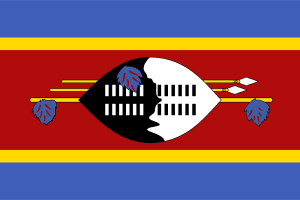
| Colors | HEX Code | RGB | CMYK |
|---|---|---|---|
| Blue | #3E5EB9 | 62, 94, 185 | 66, 49, 0, 27 |
| Red | #B10C0C | 177, 12, 12 | 0, 93, 93, 31 |
| Yellow | #FFD900 | 255, 217, 0 | 0, 15, 100, 0 |
| White | #FFFFFF | 255, 255, 255 | 0, 0, 0, 0 |
| Black | #000000 | 0, 0, 0 | 0, 0, 0, 100 |
The Flag of Swaziland is a horizontally striped flag. It has two blue stripes on the top and bottom, with a wider central red stripe, bordered by two thin yellow stripes that separate it from the blue stripes. A black and white “Nguni Shield” covers two spears and a staff and is decorated with feathered tassels. The shield is made of black and white ox-hide stretched over a wooden frame.
Meaning of the Flag of Eswatini
The blue color on the Swaziland Flag symbolizes peace and stability. The red color is for the country’s past struggles. The yellow color represents the wealth and resources of the country. The white and black colors of the shield symbolize the people who live in unity in the country. The shield and spears are a symbol of protection and defense, and the country’s cultural heritage.
History of the Flag of Eswatini
King Hadji II provided a flag for the Swazi Pioneer Corps in 1941. The flag represented the traditions and history of the Swazi who were strong warriors. The country which was called Swaziland then, proclaimed independence from Britain in 1968. King Sobhuza II took the pledge of oath and hoisted the modified flag of 1941 for the first time. The current flag of Eswatini, featuring the blue, yellow, red, yellow and blue horizontal stripes with the shield was adopted on October 6, 1968, when Eswatini gained independence as Swaziland. Africa’s last Monarchy celebrated its 50 years of independence in April 2018. King Mswati III announced changing the name of the country from Swaziland to Eswatini, and the new name became official in June, 2018. The flag, however, remained unchanged.